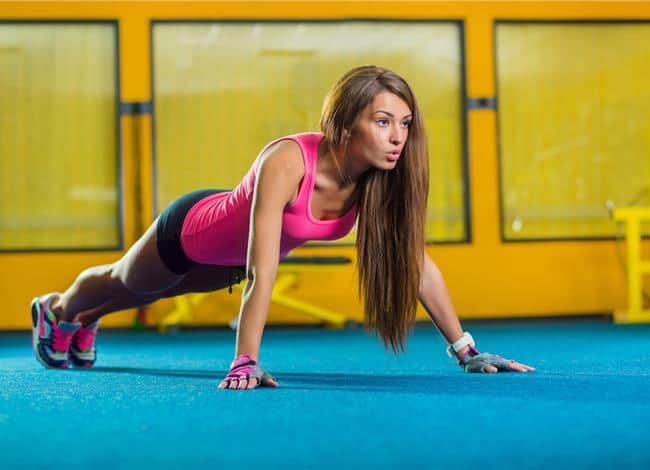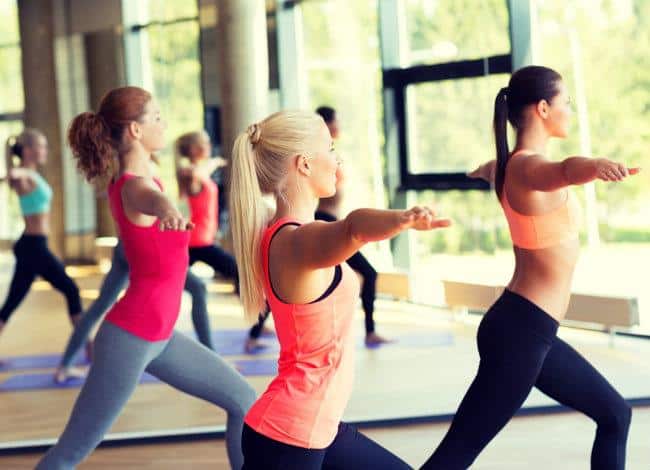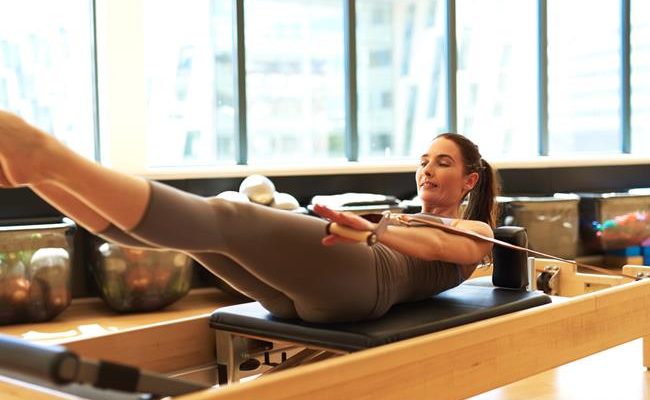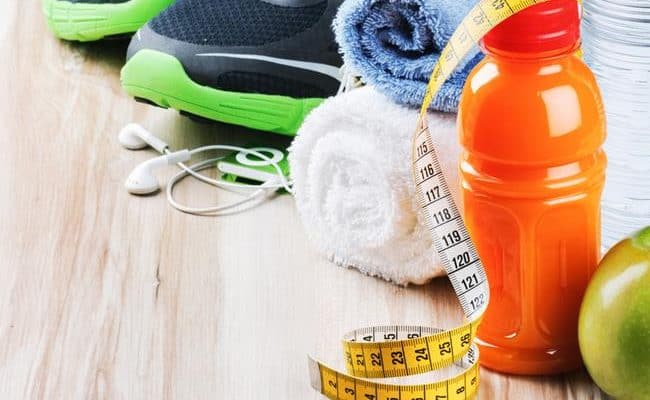
After a grueling workout, it may seem fitting that you can eat as much as you want. After all, you earned it. Your fitness tracker said you burned over 1,000 calories and you are soaked in sweat. Before you order a double size coffee drink with a muffin as a reward, you might want to reanalyze what you’re eating after a workout.
It turns out fitness devices can over estimate calorie burn, and even if you don’t use a fitness tracker we tend to overestimate in our heads calorie burn from exercise. The result could be that you’re actually eating more than what you worked off.
If you find yourself tempted to overindulge after a workout, here are some simple tips to help you stop over eating.
Add in some high intensity intervals to regulate appetite
Appetite is regulated by many hormone signals being sent back and forth to the brain from the digestive tract. Some hormones encourage us to eat and some tell us to stop eating. The way exercise affects these appetite hormones is still being fully understood from research.
Some research suggests doing high intensity intervals can help suppress appetite. For example, a 2014 study (1) found overweight men had lower food intake after high intensity or very high intensity exercise compared to moderate exercise or no exercise.
Blood levels of the hormone ghrelin, which increases appetite, were lower after high and very high intensity exercise.
The very high intensity exercise group had suppression of exercise up to 38 hours after exercise.
If you usually do the same level of exertion for exercise, try adding in some harder, short intervals. Doing a combination of moderate and high intensity can have many benefits, and it turns out adding in some high intensity training may also help lower your appetite.
Don’t take your fitness tracker as pure fact
Whether for weight loss or improving fitness, many of us rely on fitness tracking tools to monitor our progress with fitness goals. It’s estimated about 70% of the population uses some kind of device to monitor their health (2).
Fitness apps, calorie counters, pedometers, etc. can all help give a tangible visual to how much your body is working and can help track progress which can be encouraging.
As technology continues to advance, the reliance on technology for tracking health goals will probably continue.
One barrier to relying on fitness devices is their accuracy can vary, and some devices may over estimate calorie burn. This could give a false pretense to some on how many calories people burn which could lead to false justification for eating more than needed after exercise.
This doesn’t mean you need to throw out your fitness tracker; some fitness apps have been shown to be fairly accurate and they can still provide valuable feedback.
However, we need to remember our bodies are not machines or smart phones. Just because a device calculates how many calories you should have burned based on estimated equations doesn’t always translate into real life.
If your fitness device says you burned 1,000 calories that may or may not be true. It doesn’t mean you can pig out on a big meal no matter how hungry you are after exercise.
Instead of relying on the information from a tracker as fact, use it as a guide and leave room for margin.
Don’t use any fancy fitness devices? Turns out you can still overestimate your calorie burn. A 2014 study (3) found older, more obese people were more likely to overestimate their calorie expenditure from 24 hour recall of physical activity from the day before.
A 2010 study (4) also found normal weight men and women overestimate energy expenditure from exercise. When study participants were asked to compensate calories burned from exercise with food intake afterwards, they over estimated calories burnt by 3-4 fold.
Keeping this in mind may help you control your food intake after a workout. Just because you think you burned up 2,000 calories from a hard workout doesn’t mean you can then eat whatever you want. Your energy burn may not have been as high as you think.
Also don’t fall into the trap of estimating how much energy you burned from your sweat loss. That doesn’t have an accurate gauge on calorie burn; it has to do with how hot you were when you were exercising.
Make your exercise enjoyable
If you actually enjoy physical activity, instead of just viewing it as exercise, you may actually be prone to eat less afterwards according to a 2014 study from Cornell University (5).
Researchers found that when participants were told they were exercising, they ate 124% more candy afterwards than those who were told they were going on a scenic walk. The only difference was how the exercise was portrayed: something enjoyable like a scenic walk or just as exercise.
These study results suggest we may feel we need to reward ourselves after we exercise, and that may be why we justify eating more than normal after exercise. However, if we view getting physical activity as something we enjoy doing, we already get the reward from the activity. We don’t look for more reward from food afterwards.
How can this information help you stop eating after a workout?
Change your view of your exercise. Find something you actually enjoy doing and get pleasure out of. Don’t just view it as exercise; think of it as a reward or something you get to do instead of something you have to put up with.
Be grateful you get to exercise instead of dread it and want it over with.
Get a healthy balance of carbs, protein and fat
Shifting your thoughts on exercise and justifying how much you need to eat afterwards are important for helping control your eating after exercise. However, you can also do this by following some easy nutrition guidelines.
Eating a balanced mix of carbs, protein and fat can help balance blood sugar levels instead of spiking them after exercise.
Fiber from carbohydrates and protein can help you feel full for longer which may help lower food intake later in the day.
You don’t necessarily need to eat sports nutrition bars, gels or powders after a workout. Eating real food afterwards can offer the nutrients your body needs, and sometimes sports nutrition products are packed with unnecessary fats, sugars and preservatives.
Sports nutrition products can have their place for endurance athletes, but real food can be cheaper and provide whole nutrition for your body. Eating a meal compared to eating a bar can also be more satisfying.
Getting a healthy balance of carbs, protein and fat after exercise can be simple. Pair a fiber source, like fruits, vegetables, whole grains with animal or vegetarian protein and a healthy fat source like nuts, avocado, coconut oil or dairy.
It can be as simple as a sandwich, a smoothie, stir fry, etc.
A hidden source of calories and sugar before and after exercise are drinks. Sometimes sports nutrition drinks that have carbohydrates can be a benefit during or after exercise, but if you’re exercising under 2 hours, chances are you don’t need them.
They can be a potential source for extra energy your body doesn’t need. Drink water as your primary fluid source instead of sugary drinks, and remember to continue drinking water after exercise.
If you’re dehydrated, you may be more inclined to eat more as a means to get more fluid in the body.
Time your workouts before meals
If you want to eat after you exercise, plan your exercise so it’s right before a meal. That way eating after exercise makes sense and isn’t an extra source of unnecessary energy.
If you exercise in the morning, make an easy breakfast option the night before so you can eat it while you get ready or on your way to work.
If you exercise before dinner, try to do some prep beforehand so you can make dinner quickly.
Don’t exercise when you’re already hungry
When you feel like you’re already running on fumes then expect your body to burn extra fuel, you can set yourself up for swinging the other way to eating too much after exercise. Whenever we get extremely hungry, blood sugar levels drop and we tend to not make the best decisions for food intake.
High calorie options in large quantities can sound more appealing than if blood sugar levels were maybe not so low and appetite stimulating hormones out in full force.
Make sure you aren’t ravenous by the time you start your workout. This can add justification in your brain for why you need to eat more afterwards. When you’re done, you will want to eat anything and everything in sight which can set you up for easily over eating.
If you find you are usually hungry by the time you start exercising, have a small snack an hour or two before you exercise. Examples of a snack could be a piece of fruit with a slice of cheese or 2 tablespoons of nut butter, a cup of yogurt or a small handful or dried fruit and nuts.
Having a small snack beforehand if needed can take the edge off your hunger and could mean you get a better workout and don’t eat as much afterwards.
Eat when you’re hungry, stop when you’re full
One of the best ways to help stop eating after a workout can be so simple yet hard to do: listen to your body. Your body will tell you when it has had enough food, but the problem is it can be easy to overlook these signals.
Sometimes the signals for driving food intake come from the brain or our environment instead of physical hunger and fullness cues from the body.
Whether it’s after a workout or any other time of the day, eat if you’re hungry and learn how to stop when you’re full; not stuffed. One way to help you do this is to slow down when you eat. It’s easy to overeat when we eat rushed and bulldoze food into the mouth.
Instead, chew your food thoroughly and slowly. This can allow time for signaling to the brain when the stomach is full instead of overstuffed.
Instead of automatically eating after a workout, check within yourself. Are you really hungry or do you feel you need to eat something because you deserve it or that’s just what you always do?
Getting back in tune with hunger cues can take some time and patience because a typical Western lifestyle is very busy and distracted. We can get used to eating out of habit and finish eating when the food is gone instead of when we feel full.
Tracking calories burned or calories consumed through fitness apps can be helpful for some, but remember it’s always important to listen to your body above reaching a certain number.
Who are you eating with?
Having an encouraging support system is important for any health goal. To help you not over eat after exercise, try to eat with people who have the same goals as you.
When we eat with other people, they can influence what and how much we eat whether we realize it or not. If we eat with people who over indulge, it can be easier for you to personally do that as well.
If you tend to eat more when you eat by yourself, find people you can share a meal with after exercise instead of eating by yourself. The reverse is also true; eating around others that don’t overindulge can also help us not over indulge.












